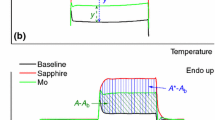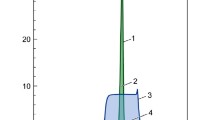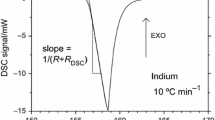Abstract
A prior study of single-run differential scanning calorimetry that leads directly to heat capacity results is extended to low temperatures (180 K). The instrument considered was the duPont dual sample differential scanning calorimeter with auto sampler and liquid nitrogen cooling accessary-II. The major error is caused by the low temperature isotherm. After optimizing all parameters, heat capacities of selenium, aluminum, quartz, polystyrene, sodium chloride were measured between 180 to 370 K. The root mean square error of all measurements on comparison with well established adiabatic calorimetry is ±2.9%.
Zusammenfassung
In einer vorangehenden Untersuchung wurde single-run DSC zur direkten Ermittlung von WÄrmekapazitÄtswerten angewendet. Diese Methode wird hier auf den niedrigen Temperaturbereich (180 K) ausgedehnt. Das benutzte GerÄt war ein duPont Doppelproben-DSCalorimeter mit Auto-Sampler und einem Flüssigstickstoff-KühlerzusatzgerÄt-II. Der grö\te Fehler wird durch die Niedrigtemperaturisotherme verursacht. Nach Optimierung aller Parameter wurden im Temperaturbereich 180–370 K die WÄrmekapazitÄten von Selen, Aluminium, Quarz, Polystyrol und Natriumchlorid gemessen. Verglichen mit der gutuntersuchten adiabatischen Kalorimetrie betrÄgt der Standardfehler aller Messungen ±2.9 %.
Similar content being viewed by others
References
Y. Jin and B. Wunderlich, J. Thermal Anal., to be published.
B. Wunderlich, J. Thermal. Anal., 32 (1987) 1949.
Software written by ourself in Quick Basic to data analysis heat capacity of sample based on the paper [2].
DuPont Instrument Thermal Analyzers, Recommended value by DSC Calibration Data Analysis Program, Version 4.0, 1988.
DuPont Instruments Thermal Analyzers, (a) The TA hotline, Fall 1989 (b) Information booklet about DuPont DSC 2910.
D. C. Ginnings and G. T. Furukawa, J. Am. Chem. Soc., 75 (1953) 522.
R. L. Hultgren, “Select Values of the Thermodynamics Properties of the Elements”, American Chemical Society for Metals, Ohio, 1973.
M. W. Chase, Jr., C. A. Davies, J. R. Downey, Jr., D. J. Frurip, R. A. McDonald and A. N. Syverud, “JANAF Thermochemical Tables” 3rd Ed., in J. Phys. Chem. Data, Vol. 14, Suppl. 1, 1985.
O. Kubaschewski and E. L. Evans, “Metallurgical Thermochemistry” Pergamon Press, New York 1958.
U. Gaur and B. Wunderlich, J. Phys. Chem. Ref. Data, 11 (1982) 313.
U. Gaur, H. C. Shu, A. Mehta and B. Wunderlich, ibid, 10 (19810 89.
H. Von Moser, Physik. Zeitschr., 37 (1936) 747.
I. Barin and O. Knacke, “Thermochemical Properties of Inorganic Substances” Springer-Verlag, New York 1973.
B. Wunderlich and U. Gaur, ACS Advances in Chemistry Series 203, Polymer Characterization, C. D. Craver, ed., Washington, DC, Pg. 195, 1983.
Author information
Authors and Affiliations
Additional information
On leave from the Dept. of Material Science, Fudan University, Shanghai, China.
This work was supported by the Division of Materials Sciences, National Science Foundation, Polymers Program, Grant # DMR 8818412 and the Division of Materials Sciences, Office of Basic Energy Sciences, U. S. Department of Energy, under Contract DE-AC05-84OR21400 with Martin Marietta Energy Systems, Inc. In addition, support by the duPont Company in acquisition of the instrumentation is acknowledged.
Rights and permissions
About this article
Cite this article
Jin, Y., Wunderlich, B. Single run heat capacity measurements. Journal of Thermal Analysis 36, 1519–1543 (1990). https://doi.org/10.1007/BF01914075
Received:
Issue Date:
DOI: https://doi.org/10.1007/BF01914075




